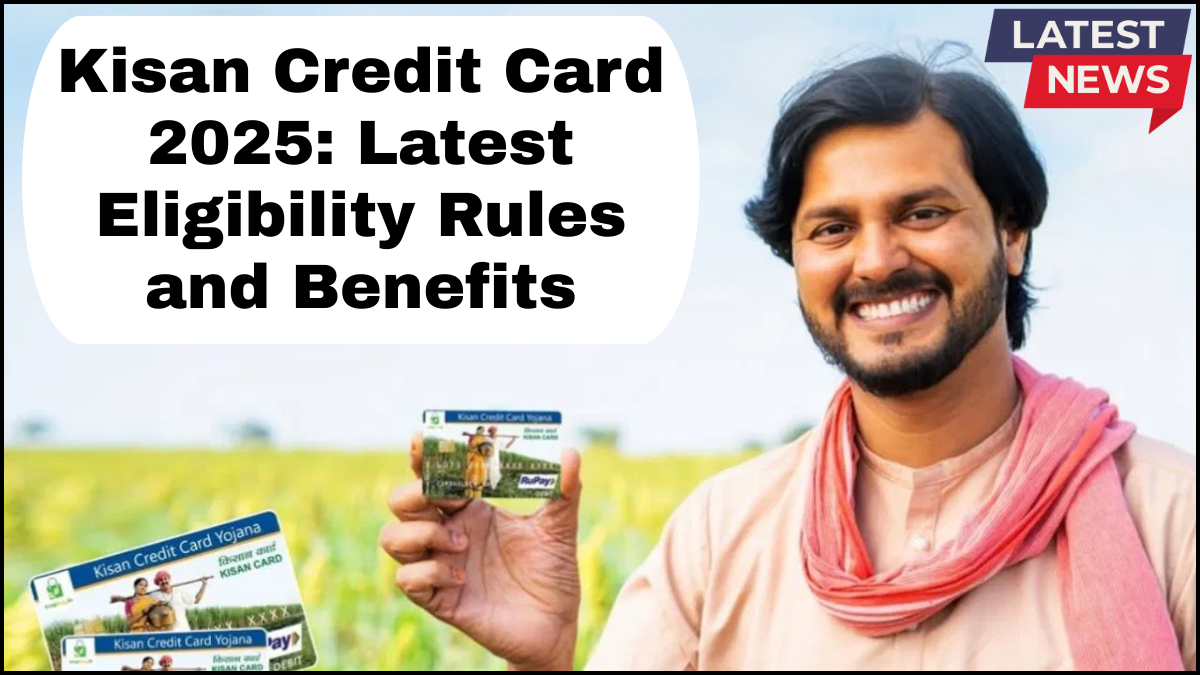The Kisan Credit Card (KCC) is one of India’s most impactful financial tools for farmers, designed to provide easy and affordable credit for agricultural needs. Since its launch in 1998, the scheme has been continuously updated to match the evolving demands of rural economies. In 2025, new eligibility norms and enhanced benefits have been introduced to make the scheme more inclusive, farmer-friendly, and supportive of modern agricultural practices.
This article will walk you through the latest eligibility rules for 2025, updated features, and the expanded benefits that make the KCC a must-have for farmers across the country.

What is the Kisan Credit Card?
The Kisan Credit Card is a government-backed scheme implemented by banks to ensure that farmers have access to timely, affordable, and flexible credit for their farming activities. It allows farmers to withdraw funds as needed to meet expenses like buying seeds, fertilizers, pesticides, equipment, or even covering irrigation and harvesting costs.
The card operates like an overdraft facility, ensuring farmers pay interest only on the amount they actually use. In many cases, loans under KCC are offered at a subsidized interest rate, making it more cost-effective than traditional loans.
Latest Eligibility Rules for 2025
The Eligibility 2025 guidelines for the Kisan Credit Card aim to widen coverage and ensure that deserving individuals—especially small and marginal farmers—can access the facility with minimal hurdles. Here are the updated eligibility criteria:
-
Eligible Applicants
-
All farmers—individuals or joint borrowers—who are engaged in crop cultivation.
-
Tenant farmers, oral lessees, and sharecroppers.
-
Self-help groups (SHGs) or joint liability groups (JLGs) of farmers.
-
Fishermen, poultry farmers, and livestock owners (under allied activities category).
-
-
Age Requirement
-
Minimum age: 18 years.
-
Maximum age: 75 years (with a co-borrower required if the applicant is above 60).
-
-
Proof of Engagement in Farming
-
Applicants must provide proof of agricultural landholding or evidence of being engaged in allied activities.
-
Lease agreements or revenue records are acceptable for tenant farmers.
-
-
Creditworthiness
-
Clean repayment history is preferred, but the government has eased rules for first-time borrowers to promote inclusion.
-
Farmers with existing loans must ensure they are not in default to be eligible for enhanced limits.
-
-
Documentation Requirements
-
Aadhaar card, PAN card, or voter ID.
-
Proof of residence.
-
Land records or lease agreements.
-
Recent passport-sized photographs.
-
Key Benefits of Kisan Credit Card in 2025
The KCC in 2025 has evolved beyond just seasonal crop loans. Here’s what farmers can expect:
1. Affordable Credit with Subsidies
Interest rates are as low as 4% per annum after interest subvention for prompt repayment. This ensures farmers can borrow without falling into the trap of high-interest informal loans.
2. Flexible Loan Limits
The credit limit is assessed based on cropping patterns, cultivation expenses, and household requirements. Limits can go up to ₹3 lakh or more, depending on eligibility and repayment history.
3. Coverage for Allied Activities
Apart from crop cultivation, the KCC now covers dairy farming, fisheries, poultry, and other allied sectors—making it useful for farmers with diversified income streams.
4. Insurance Protection
KCC holders are eligible for crop insurance under the Pradhan Mantri Fasal Bima Yojana (PMFBY) and personal accident insurance up to ₹50,000–₹1,00,000.
5. Simplified Renewals
Once issued, the card is generally valid for 3–5 years, with annual reviews and limit enhancements based on performance.
6. Digital Access
Farmers can now link their KCC with mobile banking and digital wallets, enabling easy withdrawals and payments without visiting bank branches frequently.
How to Apply for KCC in 2025
-
Visit a Participating Bank – This includes public sector banks, private banks, and cooperative banks.
-
Fill out the KCC Application Form – Available both offline and online via bank websites.
-
Submit Documents – Proof of identity, residence, and farming activity.
-
Credit Assessment – Bank verifies eligibility and determines the loan limit.
-
Issuance of Card – Upon approval, farmers receive their physical or digital KCC for immediate use.
Expert Tips for Farmers Applying in 2025
-
Maintain a good repayment record to enjoy enhanced credit limits in future.
-
Apply before the sowing season to ensure funds are available when needed.
-
Keep track of government notifications—often, interest subvention schemes and waivers are announced mid-year.
-
Explore allied activity coverage if you have multiple income sources from agriculture.
FAQs on Kisan Credit Card 2025
Q1: Is the Kisan Credit Card only for landowners?
No. Tenant farmers, sharecroppers, and those engaged in allied activities can also apply under the Eligibility 2025 rules.
Q2: What is the maximum loan limit under KCC in 2025?
It varies based on farming expenses and credit history but can go up to ₹3 lakh or more.
Q3: Do I have to repay the entire amount in one year?
KCC loans are typically repayable after the harvest, but terms may vary depending on the crop cycle and bank policy.
Q4: Can KCC be used for non-farming expenses?
While primarily for farming, a portion may be used for household or consumption needs, as per bank guidelines.
Q5: Is digital KCC available in 2025?
Yes. Many banks now issue KCC in a digital format for easy and secure transactions.
click here to learn more